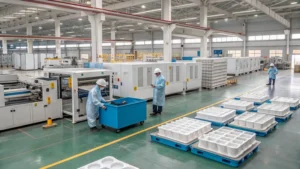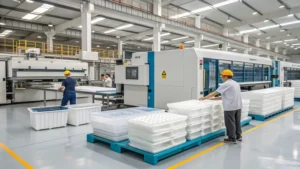
In the fast-paced world of plastic extrusion, where efficiency and reliability are critical, unplanned downtime can lead to significant production losses and increased costs. Predictive maintenance1 offers a transformative solution by using data and analytics to forecast equipment failures before they occur, enabling timely repairs and maintenance. This proactive approach not only minimizes unexpected breakdowns but also enhances product quality and reduces operational costs over time. In this article, we’ll explore how predictive maintenance can improve plastic extrusion machinery, diving into its benefits, challenges, and practical applications.
Predictive maintenance uses data to forecast equipment failures in plastic extrusion machinery, reducing downtime and costs while improving efficiency and product quality.
Understanding how predictive maintenance works and its advantages can help manufacturers decide if it’s the right strategy for their operations. Read on to discover how this technology can be tailored to enhance your plastic extrusion processes.
Predictive maintenance reduces unplanned downtime in plastic extrusion machinery.True
By predicting potential failures before they occur, maintenance can be scheduled during planned downtime, minimizing disruptions to production.
Predictive maintenance is too expensive for small plastic extrusion operations.False
While there is an initial investment, the long-term cost savings from reduced downtime and improved efficiency often outweigh the upfront costs, even for smaller operations.
What is Predictive Maintenance and How Does It Help Plastic Extrusion?
Predictive maintenance is a forward-thinking maintenance strategy that utilizes data analytics, machine learning, and IoT sensors2 to monitor equipment health in real time. By analyzing data from various sources—such as vibration, temperature, and pressure sensors—predictive maintenance systems identify patterns and anomalies that signal potential failures. This allows maintenance teams to address issues before they escalate into costly breakdowns, ensuring continuous operation and optimal performance of plastic extrusion machinery.

Predictive maintenance leverages data analytics3, machine learning, and IoT sensors to monitor equipment health in real-time, preventing unexpected breakdowns in plastic extrusion machinery.
| Maintenance Strategy | Description | Pros | Cons |
|---|---|---|---|
| Reactive Maintenance | Fixing equipment after it fails | Low initial cost | High downtime, risk of severe failures |
| Preventive Maintenance | Scheduled maintenance at regular intervals | Reduces unexpected failures | May involve unnecessary maintenance, higher labor costs |
| Predictive Maintenance | Uses data to predict and prevent failures | Minimizes downtime, optimizes schedules | Requires investment in tech and skills |
How Predictive Maintenance Works in Plastic Extrusion
In the context of plastic extrusion, predictive maintenance follows a structured process:

-
Data Collection: Sensors are installed on critical components like screws, barrels, and dies to monitor parameters such as temperature, pressure, and vibration.
-
Data Analysis: Advanced analytics and machine learning algorithms process this data to detect patterns and predict potential failures.
-
Actionable Insights: When an issue is flagged—such as abnormal vibration indicating screw wear—the system alerts maintenance teams to schedule repairs during planned downtime.
For instance, if sensors detect unusual pressure spikes in the barrel, it might suggest a blockage or wear, prompting preemptive action to avoid a production halt.
Predictive maintenance can prevent all equipment failures.False
While it significantly reduces failures, it cannot predict every issue, especially those caused by external factors like power surges.
Predictive maintenance improves product quality in plastic extrusion.True
By ensuring consistent machine operation, it helps maintain high-quality output, vital for industries like automotive and packaging.
What are the Benefits of Predictive Maintenance in Plastic Extrusion?
Predictive maintenance delivers a range of advantages that make it an appealing option for plastic extrusion manufacturers looking to boost efficiency and cut costs.
Predictive maintenance reduces downtime, improves product quality, and saves costs by preventing unexpected failures and optimizing maintenance schedules.

Reduced Downtime
By forecasting equipment failures, predictive maintenance allows repairs to be scheduled during non-production periods, minimizing disruptions. A real-world example comes from MONDI, where AI-driven predictive maintenance reduced downtime in plastic film production Predictive Maintenance Case Study: Plastic film production at MONDI.
Improved Product Quality
Stable machine performance ensures consistent extrusion, producing high-quality plastic products essential for precision-dependent industries like automotive and packaging.

Cost Savings
Avoiding emergency repairs and optimizing maintenance schedules lowers overall costs. Davis-Standard’s DS Activ-Check system, for instance, monitors extruder components to reduce unplanned downtime, showcasing tangible savings Real-time, predictive-maintenance system for extruders reduces unplanned downtime.
Predictive maintenance eliminates the need for preventive maintenance.False
While it reduces the frequency of preventive maintenance, some scheduled checks remain necessary for optimal performance.
Predictive maintenance can lead to long-term cost savings.True
By preventing failures and optimizing maintenance, it reduces overall operational costs over time.
What are the Challenges of Implementing Predictive Maintenance?
Despite its benefits, predictive maintenance comes with hurdles that manufacturers must navigate to successfully integrate it into their operations.
Implementing predictive maintenance requires initial investment, skilled personnel, and consideration of material compatibility, which can be challenging for some operations.

Initial Investment Costs
The setup—installing sensors, acquiring analytics software, and training staff—demands an upfront financial commitment, which may deter smaller operations.
Need for Skilled Personnel
Interpreting complex data and acting on predictions requires trained professionals, adding to operational demands.
Material Compatibility Issues
Different plastics processed in extrusion affect machine wear variably. For example, abrasive materials might accelerate screw wear, necessitating tailored monitoring adjustments.
Predictive maintenance is only beneficial for large-scale operations.False
Smaller operations can also benefit from reduced downtime and cost savings, though the initial investment may be proportionally higher.
Material compatibility affects predictive maintenance strategies.True
Different plastics cause varying wear on machinery, requiring customized maintenance approaches.
How to Implement Predictive Maintenance in Plastic Extrusion
Adopting predictive maintenance involves a clear plan to ensure it aligns with your machinery and operational goals.
Implementing predictive maintenance involves identifying critical components, selecting parameters to monitor, installing sensors, and analyzing data to predict failures.

Steps to Implement Predictive Maintenance
-
Identify Critical Components4: Target parts prone to failure, such as screws, barrels, and dies.
-
Select Parameters to Monitor: Focus on key indicators like temperature, pressure, and vibration.
-
Install Sensors5: Equip machinery with tools like thermocouples for temperature and accelerometers for vibration.
-
Data Analysis6: Use machine learning to identify anomalies and predict failures.
-
Take Action: Schedule maintenance based on system alerts to prevent breakdowns.
Predictive maintenance requires continuous data monitoring.True
Real-time data collection is essential for accurate predictions and timely interventions.
All plastic extrusion machines can easily integrate predictive maintenance.False
Older machines may require retrofitting with sensors, which can be challenging and costly.
Conclusion
Predictive maintenance is revolutionizing plastic extrusion7 by leveraging data to enhance efficiency, reduce costs, and improve product quality. By predicting and preventing equipment failures8, it ensures continuous operation and optimal performance. Though challenges like initial costs and the need for skilled staff exist, the long-term benefits make it a compelling investment for manufacturers of all sizes. Embracing this technology can position plastic extrusion operations at the forefront of modern manufacturing.
Predictive maintenance is the future of plastic extrusion maintenance strategies.True
Its ability to prevent failures and optimize operations positions it as a key strategy for modern manufacturing.
-
Explore how predictive maintenance can revolutionize manufacturing processes and enhance efficiency. ↩
-
Discover the impact of IoT sensors on real-time monitoring and maintenance strategies in manufacturing. ↩
-
Learn how data analytics plays a crucial role in predicting equipment failures and optimizing maintenance schedules. ↩
-
Understanding critical components helps in proactive maintenance and reducing downtime. Explore this link for detailed insights. ↩
-
Installing the right sensors is crucial for effective monitoring. Learn about the best options available for your needs. ↩
-
Data analysis is key to enhancing machinery reliability. Discover advanced techniques and case studies in this resource. ↩
-
Exploring this link will reveal how predictive maintenance enhances efficiency in plastic extrusion processes. ↩
-
Learning about equipment failures can help manufacturers implement better preventive measures and improve reliability. ↩








